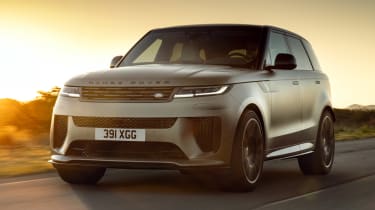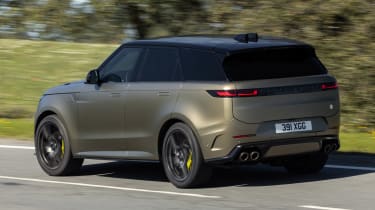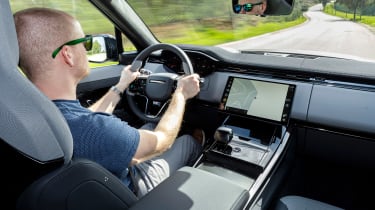New Range Rover Sport SV 2024 review: staggering SUV performance
The new Range Rover Sport SV boasts stunning pace, while retaining the standard car's impressive levels of comfort and off-road ability

Verdict
From a performance point of view, it’s hard to emphasise just how much of a giant leap forward the Range Rover Sport SV has taken beyond the standard car. The changes to the suspension in particular have been transformative, and as a result, the SV is one of the sharpest models in its class. That it does so without unduly sacrificing comfort – or off-road ability – is even more staggering.
If you were asked to pick a venue to launch a new 2.5-tonne SUV, a racetrack most likely wouldn’t be the first place that springs to mind. But we certainly admire the confidence of Jaguar Land Rover, because that’s exactly where it decided to let us loose in its latest Range Rover Sport SV. Just as eye-brow raising is that after our experience on track plus on and off-road, that confidence appeared completely justified.
That’ll likely come as a surprise to anyone with experience of the previous Range Rover Sport SVR. As big as its personality was, it lacked the sharpness or sophistication to be mentioned in the same breath as the most driver-focused SUVs – such as the Porsche Cayenne Turbo GT and the Aston Martin DBX 707. This new model is completely different in its approach.
More reviews
Car group tests
In-depth reviews
Road tests
- New Range Rover Sport P510e 2023 review
- New Range Rover Sport 2022 review
- New Range Rover Sport P530 2022 review
- New Range Rover Sport ride review
Used car tests
There’s no questioning the fact that the standard Sport is superbly comfortable and refined, but it doesn’t exactly live up to the ‘Sport’ part of its name. To turn the SV into a driver’s car, the changes are extensive, and the obvious place to start was with the suspension. Here, the air springs are kept in check by hydraulically-interlinked adaptive dampers and a pitch control system – an industry first, according to Land Rover. The semi-active arrangement can give a very wide bandwidth between comfort and roadholding, but also such precise control over each corner that it does away with anti-roll bars completely.
The height adjustable air springs sit 10mm lower than in the standard car, which dictates all-new geometry. It’s controlled by the most direct steering rack fitted to a production Land Rover, which works with recalibrated rear-wheel steering system. A set of 23-inch forged wheels save unsprung mass compared to standard rims, and the result is that the SV can pull 1.1G through the turns. On all-season tyres.
However, spend another £6,900 and Land Rover will fit a set of 23-inch carbon fibre wheels. At this size, they’re another world first, and help to trim a whopping 8.9kg more on each corner. The carbon wheels come wrapped in a set of Michelin Pilot Sport 5 summer tyres developed specifically for this car, which sees that peak G figure climb even higher.
Further weight is saved with optional carbon ceramic brake discs (£7,000), which trim another 34kg compared to the cast iron discs. The items up front measure 440mm – that’s over 17 inches, or larger than the wheels of many family cars – and are gripped by unique Brembo calipers. Its eight pistons form a cross shape, which allows sufficient braking force while bringing some of the weight closer to the centre of the wheel. Both the carbon wheels and uprated brakes were fitted to our test car.
These weight saving measures, plus a carbon fibre bonnet and a range of other carbon trim pieces on the SV-specific body kit, help to trim 76kg from the overall weight. It doesn’t change the fact that there’s still significant mass to haul around, but then the engine has an emphatic answer for that.
Gone is the old supercharged 5.0-litre V8, and in its place is a 4.4-litre twin-turbocharged V8 (originally a BMW sourced unit, but with plenty of Range Rover-specific tuning) with mild-hybrid tech. The result is 626bhp and 750Nm of torque – 60bhp and 50Nm up on the old car, yet with emissions reduced by 15 per cent. It’s all sent to the road via an eight-speed gearbox and an active rear differential.
It barely takes a corner of the glorious Portimao circuit to discover what a profound effect all of this has on the way the SV behaves. Push into a corner in a way that would see the standard car wallow on its air springs and the stability control kill forward momentum, here the turn in is positive and grip is enormous.
Prod the SV button on the steering wheel and things become even sharper. The suspension drops a further 15mm (giving the side effect of some more camber), stiffens the dampers, and changes the response of the throttle and gearbox. The interlinked suspension is almost spooky in its ability to contain body roll; were it not for the commanding view of the road ahead, you’d be convinced you were driving something as low slung as a Porsche Panemera.
It achieves all of this while maintaining just enough movement to register how your throttle inputs can adjust the car’s balance. Lift off the right pedal through the long final corner leading onto the long start-finish straight, and the nose dutifully tucks back towards the apex. As the corner gradually opens out and the speed increases, you do become aware of the car’s mass, but for the most part it’s incredibly well contained.
The steering helps here, too. While some four-wheel steering systems don't quite feel like the axles quite sync up, but here the rack feels so natural, precise and confidence inspiring. There’s just enough speed to make it feel keen to turn in without feeling hyperactive.
Such a composed chassis allows you to fully exploit every last horsepower from that V8 engine. A 0-62mph time of 3.8 seconds (or 3.6 with the carbon wheels), is more than rapid enough to keep pace with the competition, though the cabin is so serene that it makes the relentless surge feel all the more surreal. There’s a little too much traction for the four wheels to slip much in the dry, but there is a rear-biased power delivery which adds to the excitement.
Less exciting is the noise; the engine makes a pleasing but slightly muted growl, and it can’t match the sense of occasion of its predecessor’s roaring supercharged V8. We are being picky, though. With all of that performance, the good news is that speed is scrubbed off in phenomenal fashion by those carbon brakes, which didn’t even imply the merest hint of fade.
All of this on-track ability might leave you thinking the SV would be unbearable to live with on road. However, it couldn’t be further from the reality. While the standard car’s floatiness is gone, it’s replaced with much tighter control and a beautiful ability to round off harsher bumps. Thanks to the lack of any roll bars connecting the wheels at each side, there’s less of a low-speed rocking motion as you travel across uneven surfaces. Refinement remains as impressive as ever, and even the carbon brakes feel smooth – they don’t nip and grab when cold like some rival setups do.
Perhaps most astounding of all is that all of this is possible while barely sacrificing the Range Rover Sport’s off-road ability. Here, it still blows any of its nearest rivals away.
So are there any flaws? Well the eight speed gearbox can’t match the polished feel elsewhere; full-bore upshifts are jerky, downshifts don’t always arrive when you’d like in auto mode and, in manual mode, the responses aren’t as instantaneous as those in a Cayenne. The steering wheel mounted shift paddles have a translucent top to give a better view of the column stalks behind, but we’d trade that for the beautifully tactile metal shifters that you’ll find in a Maserati Grecale Trofeo.
Furthermore, the model year updates for the 2024 Range Rover Sport lineup have ditched the old physical controls for the climate and drive mode functions and have relegated them onto the infotainment touchscreen. As well as they work for controls of this type, they’re not as intuitive as the dials and buttons they have replaced.
A more positive introduction comes exclusive to the SV, and that’s the seats. They’re comfy and supportive, but the most intriguing feature is what Range Rover calls the Body and Soul System; four transducers in each seat work with AI software to send pulses through the seat, replicating the lower frequency notes and rhythms of your favourite music. They’re a little odd at first, but once you’ve got used to it, listening to music without them seems just a little flat and boring.
Of course, all of this does not come cheap. The Range Rover Sport SV starts from £171,460 – a decent climb up from the £154,000 Porsche Cayenne Turbo E-Hybrid Coupe fitted with the GT Pack. However, it’s also less expensive than the Aston Martin DBX 707 – to the tune of £20k or so, despite feeling like it’s moved the performance SUV game on another step.
| Model: | Range Rover Sport SV |
| Price: | £171,460 |
| Powertrain: | 4.4-litre V8 twin-turbo MHEV |
| Power/torque: | 626bhp/750Nm |
| Transmission: | Eight-speed auto, four-wheel drive |
| 0-62mph: | 3.8 seconds |
| Top speed: | 180 mph |
| Economy/CO2: | 22.7mpg/282g/km |
| Dimensions (L/W/H): | 4,946/2,047/1,814mm |
| On sale: | Now |






